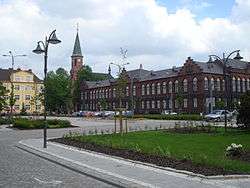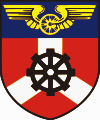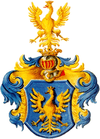Bohumín
Bohumín (/ˈboʊhuːmiːn/; Czech pronunciation: [ˈboɦumiːn] (![]()
![]()
Bohumín | |
|---|---|
Town | |
 Masaryk Square and the town hall in Nový Bohumín | |
 Flag  Coat of arms | |
 Bohumín Location in the Czech Republic | |
| Coordinates: 49°54′13″N 18°21′16″E | |
| Country | Czech Republic |
| Region | Moravian-Silesian |
| District | Karviná |
| First mentioned | 1256 |
| Town parts | |
| Government | |
| • Mayor | Petr Vícha (ČSSD) |
| Area | |
| • Total | 31.02 km2 (11.98 sq mi) |
| Elevation | 198 m (650 ft) |
| Population (2019-01-01[1]) | |
| • Total | 20,690 |
| • Density | 670/km2 (1,700/sq mi) |
| Time zone | UTC+1 (CET) |
| • Summer (DST) | UTC+2 (CEST) |
| Postal code | 735 31 to 735 81 |
| Website | www.mesto-bohumin.cz |
Bohumín consists of Old Bohumín and industrial New Bohumín, while several villages are administratively part of the town. The majority of citizens are Czech; many citizens have Polish ancestry, although the Polish minority in Bohumín is small nowadays. Before World War II, the town was inhabited by a large German community. Nowadays the city is known as having one of the largest communities of Romani people in the Czech Republic.
History
The town was first mentioned in a border agreement between Władysław Opolski, the duke of Opole and Racibórz and Ottokar II of Bohemia, in 1256 as Bogun (today's Old Bohumín).[2][3] Historical documents regarding the first centuries of the town are scarce. King Louis II granted the town and château of Bohumín to George, Margrave of Brandenburg-Ansbach in 1523. The town began to develop during rule by the House of Hohenzollern, although further development of Bogumin was halted by frequent epidemics of bubonic plague and floodings of the Olza. It was officially known in German as Oderberg, and by the end of the 16th century the majority of citizens followed Protestantism. The successor after the Hohenzollerns in 1620 was Lazar Henckel, whose family of bankers and entrepreneurs hailed from Habsburg-ruled Hungary. In 1624 only 138 permanent residents lived in the town. After defeating Maria Theresa of Austria during the Silesian Wars, King Frederick II of Prussia annexed most of Silesia, although Oderberg remained in Austrian Silesia. The town successively became part of the Austrian Empire (1804) and Austria-Hungary (1867).
After the Revolutions of 1848 in the Austrian Empire a modern municipal division was introduced in the re-established Austrian Silesia. The town became a seat of a legal district at first in Friedek and since 1868 in the Freistadt political district.
At the end of the 19th century a wire and rolling mill was built by German industrialists from Berlin, Albert Hahn and Heinrich Eisner. In 1872 the important Kassa-Oderberg railway line was opened to traffic in a nearby Schönichel (Šunychl), which later outgrew Oderberg; this increased the town's importance and contributed to the Polish - Czechoslovak dispute over Cieszyn Silesia after World War I.
According to the censuses conducted in 1880, 1890, 1900 and 1910 the population of the town grew from 1,839 in 1880 to 5,810 in 1910. The dominant language spoken colloquially shifted through the censuses. In 1880 and 1890 the majority were Polish-speakers (58.1% in 1880 and 64.8% in 1890), followed by German-speakers (34.8% in 1880 and 27.6% in 1890) and Czech-speakers (6.9% in 1880 and 7.6% in 1890). In 1900 and 1910 the majority were German-speakers (52.8% in 1900, 54.5% in 1910), followed by Polish-speakers (41.7% in 1900 and 38.2% in 1910) and Czech-speakers (5.3% in 1900 and 7.3% in 1910). In terms of religion, in 1910 the majority were Roman Catholics (91.7%), followed by Protestants (206 or 3.5%), Jews (129 or 2.2%) and others (141 or 2.6%).[4]
After the division of Cieszyn Silesia in 1920, the town became part of Czechoslovakia. Following the Munich Agreement, Bohumín and the Zaolzie region were annexed by Poland in October 1938. The town was then annexed by Nazi Germany at the beginning of World War II. On 1 May 1945 Bohumín was taken by Soviet troops of the 1st Guards Army. After the war it was restored to Czechoslovakia and the remaining German population was expelled westward.
There are few historical buildings remaining in Old Bohumín. It was always small with mostly wooden houses, which burnt down in frequent fires, as did the old town hall with its high tower. An old church still remains however; it was rebuilt in 1850 from its Gothic style to its current form. Another landmark is a tomb of the Henckels, former owners of Bohumín.
The most important landmarks of New Bohumín are the Catholic Heart of Jesus Church from 1896; town hall from 1897–1898; complex of former German schools from 1894–1914; and the Lutheran church from 1901.
Transport
Bohumín is one of the most important railway junctions in the Czech Republic. There are lines in the directions of Ostrava ( - Břeclav - Vienna / - Olomouc - Prague), Petrovice u Karviné ( - Katowice), (both built by the Austrian Northern Railway) and Chałupki ( - Racibórz and Wodzisław Śląski). Another important line in the direction of Český Těšín, Žilina, and Košice also originally started here, but was relocated in 1963 and now separates from the line to Petrovice u Karviné in Dětmarovice. There is also an important depot in Bohumín. All trains of the company Czech Railways, RegioJet a LEO Express are standing there. LEO Express also operates a bus line to Polish cities Katowice and Kraków.
Twin towns — sister cities
Bohumín is twinned with:[5]




References
- "Population of municipalities of the Czech republic". Czech Statistical Office. Retrieved 2019-04-30.
-
- Hosák, Ladislav; Rudolf Šrámek (1970). Místní jména na Moravě a ve Slezsku I, A-L. Praha: Academia. pp. 84–85.
- Panic, Idzi (2010). Śląsk Cieszyński w średniowieczu (do 1528) [Cieszyn Silesia in Middle Ages (until 1528)] (in Polish). Cieszyn: Starostwo Powiatowe w Cieszynie. p. 286. ISBN 978-83-926929-3-5.
- Piątkowski, Kazimierz (1918). Stosunki narodowościowe w Księstwie Cieszyńskiem (in Polish). Cieszyn: Macierz Szkolna Księstwa Cieszyńskiego. pp. 272, 289.
- "Zpřístupnění Odry a Olše". mesto-bohumin.cz (in Czech). Město Bohumín. Retrieved 2019-09-17.
- Cicha, Irena; Jaworski, Kazimierz; Ondraszek, Bronisław; Stalmach, Barbara; Stalmach, Jan (2000). Olza od pramene po ujście. Český Těšín: Region Silesia. ISBN 80-238-6081-X.

